Empire Day I & II
Chronology of the Empire Days
For approximately 12 months, beginning in Spring, 1938 public attention was drawn to an expermental boat being developed by Edward Spurr upon designs he and T.E. Shaw (Lawrence of Arabia) had drawn up. Originally part of a project for a larger high-speed warship, that element was abandoned sidelined upon Lawrence's death in 1935.
Spurr, who was born in Bradford, Yorkshire, England in 1907 and had been Hubert Scott-Paine’s chief draughtsman. He envisioned a boat for speed records that would feature an enclosed cockpit, a propellor mounted amidships, a dagger-like rudder. It had "one and a half steps" and two aerofoil wing-floats to provide lift. This would be realized as Empire Day. At 16 feet long, it was built accomodate two different engines of somewhat different sizes. Special fuel would be used.
The two photographs below are from the first public showing of the craft.
Throughout 1938 the Empire Day project dealt with a number of challenges including availability of the the special fuel, unreliable propellors, debilitating fumes and, at the end of the summer, a fire which caused extensive damage.
Early 1939 saw the appearance of Empire Day II with somewhat modified design.
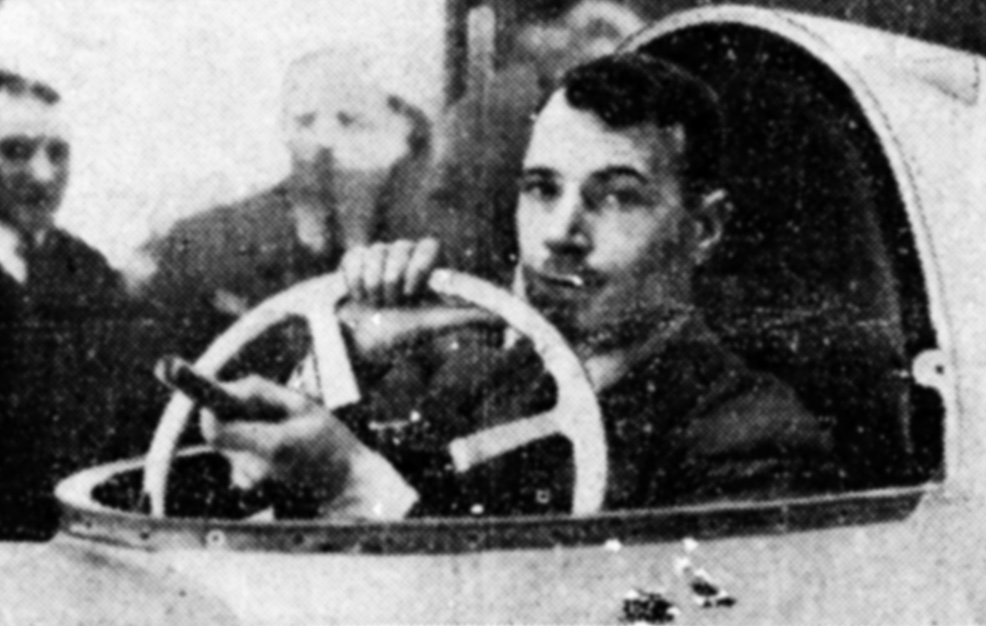
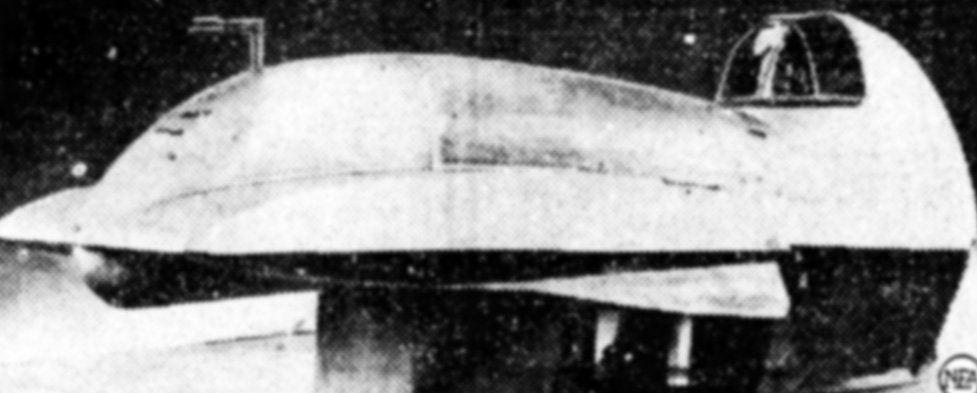
"This contraption, more fish than fowl, is the dream of Col. T. E. Lawrence and Edward Spurr, as to what it takes to revolutionize speedboat racing. The craft was designed in great secrecy at Slough, England. It is a single seater with the cockpit completely enclosed. The steering wheel must be removed to permit the driver to enter, as Spurr demonstrates (top above). The boat is 16 feet long, six feet in breadth and is powered with a 1½ liter supercharged engine."
— Arizona Daily Star, June 7, 1938
* * *
From Kevin Desmond's "Powerboat":
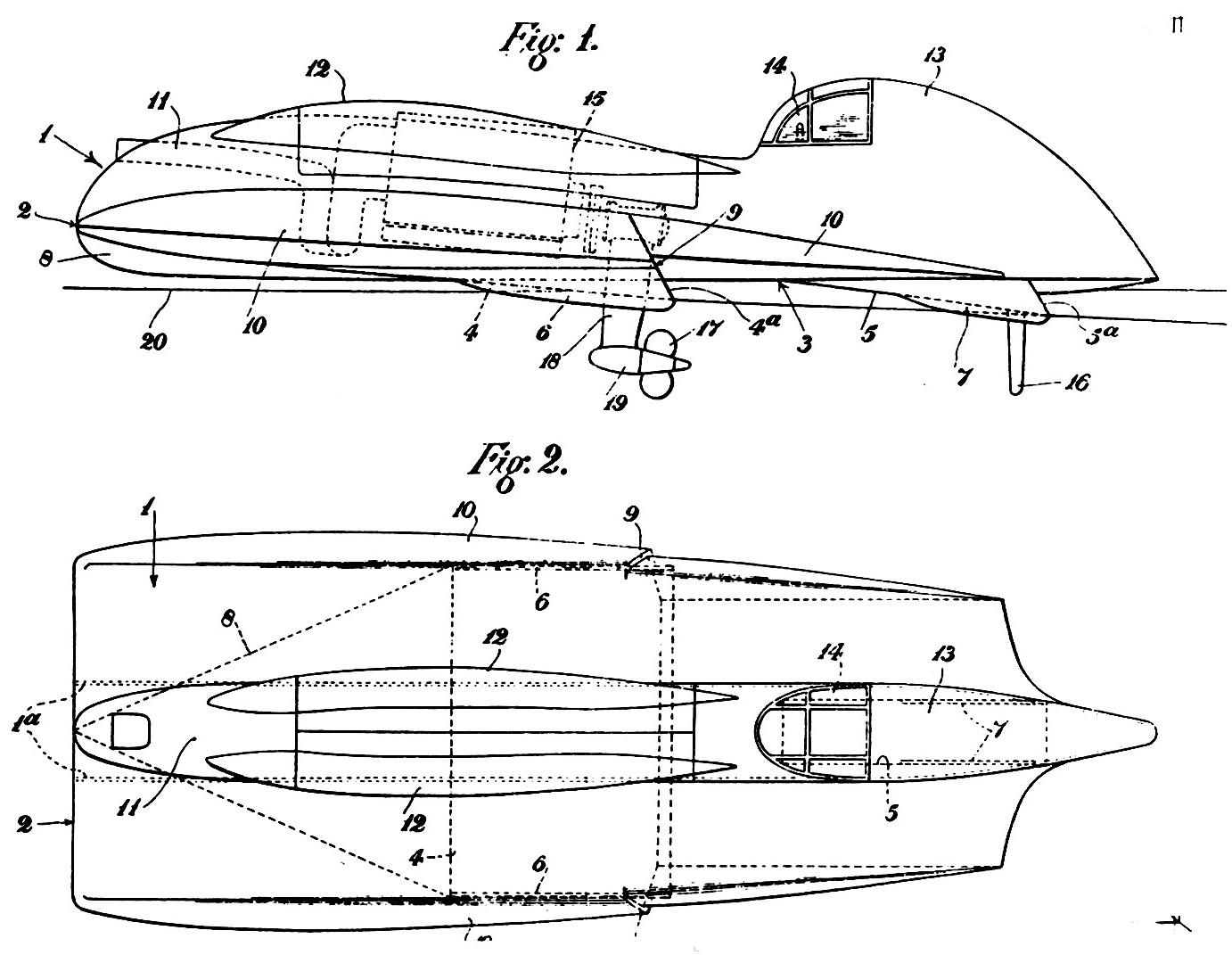
"Even more revolutionary was the 16-foot steel and alloy Empire Day. She had been conceived some six years before by Scott-Paine’s chief draughtsman, a 26-year-old research engineer from Bradford called Edward Spurr, working in conjunction with Aircraftsman T E Shaw (T E Lawrence of Lawrence of Arabia fame who had changed his name by deed poll.) The idea had been for an 80 mph-plus totally streamlined torpedo boat, a group of which could make up a wasp fleet. For three years, Spurr and Shaw worked together on the project, making nearly 70 miniature models which they put through innumerable tests. Following Shaw’s death in a motorcycle accident in 1935, Spurr pressed on alone for two years, until in September 1937, whilst residing at Shepperton, Middlesex, he filed a complete patent specification for ‘a motor-driven speedboat provided with a hull of cambered aerofoil contour in a longitudinal or side elevation.'
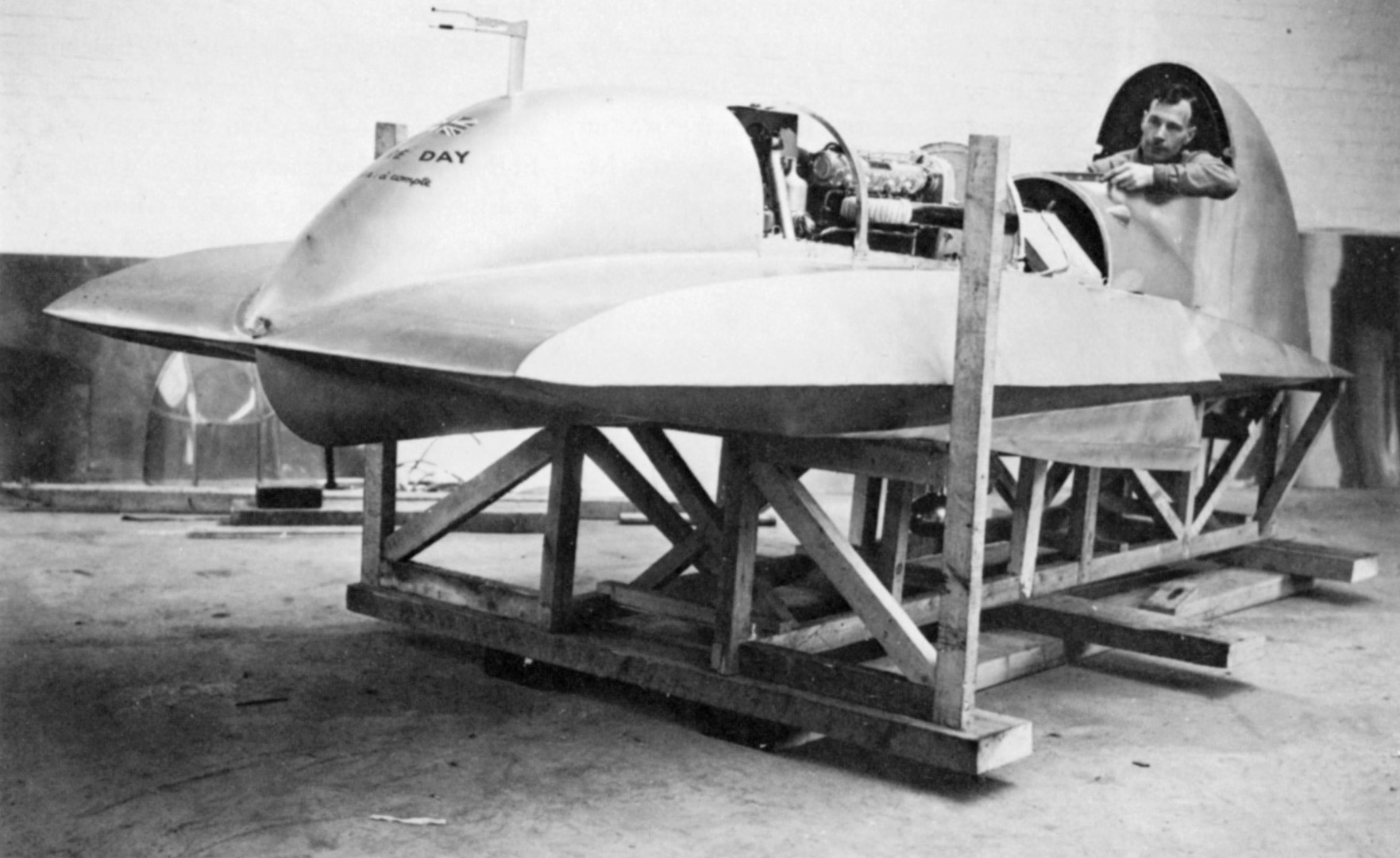
Soon after that, Spurr contracted with an aircraft engineering and construction company, R Malcolm Ltd of Slough, Bucks, to build the 16-foot craft in top secrecy at an estimated cost of £8000, paid for by Lord Strabolgi.
Spurr publically described his configuration as a ‘one-and-a-half stepper’, showing how one step was twice as deep as the other in order to reduce resistance, so that the craft would skim or hover over the water with her two wing-floats clear. There was an enclosed, tailor-made cockpit which to enter Spurr had to remove the steering wheel each time; once inside he would wear a safety harness and control the entire craft manually because, he reasoned, the hands are more sensitive than the feet.
Most revolutionary of all, this hovercraft was designed to take two totally different engines. The four-cylinder supercharged 1½-litre Spurr engine, giving 150 hp at 6000 rpm was to drive the craft to a new 1½-litre clas record of over 70 mph, so breaking the current mark of 60 mph, then held by Italy. Then by changing engines to the 960 hp Napier Lion aero-engine, Empire Day would then improve on Sir Malcolm Campbell’s 130mph record.
Initial trials on Windermere met with water-cooling defects, transmission troubles and repeated stalling of the 1½-litre engine. To make the steering less sensitive, Spurr had to fit a damper on the daggerlike rudder. On 9 September he had made a northbound run at 73 mph and started back, when the nine-inch prop flattened out under strain. A week later, making a new run at 45 mph, Spurr detected fumes and within seconds flames were coming through the fireproof bulkhead. Spurr managed to decelerate and although blinded and nearly suffocated, brought the boat to a standstill. Fortunately, his mechanics were on board a fast speedboat and arrived in time to release Spurr from his enclosed cockpit. Empire Day was transported south for major repairs."
--- Kevin Desmond
* * *
From Gérald Guétat's "Classic Speedboats 1916-1939":
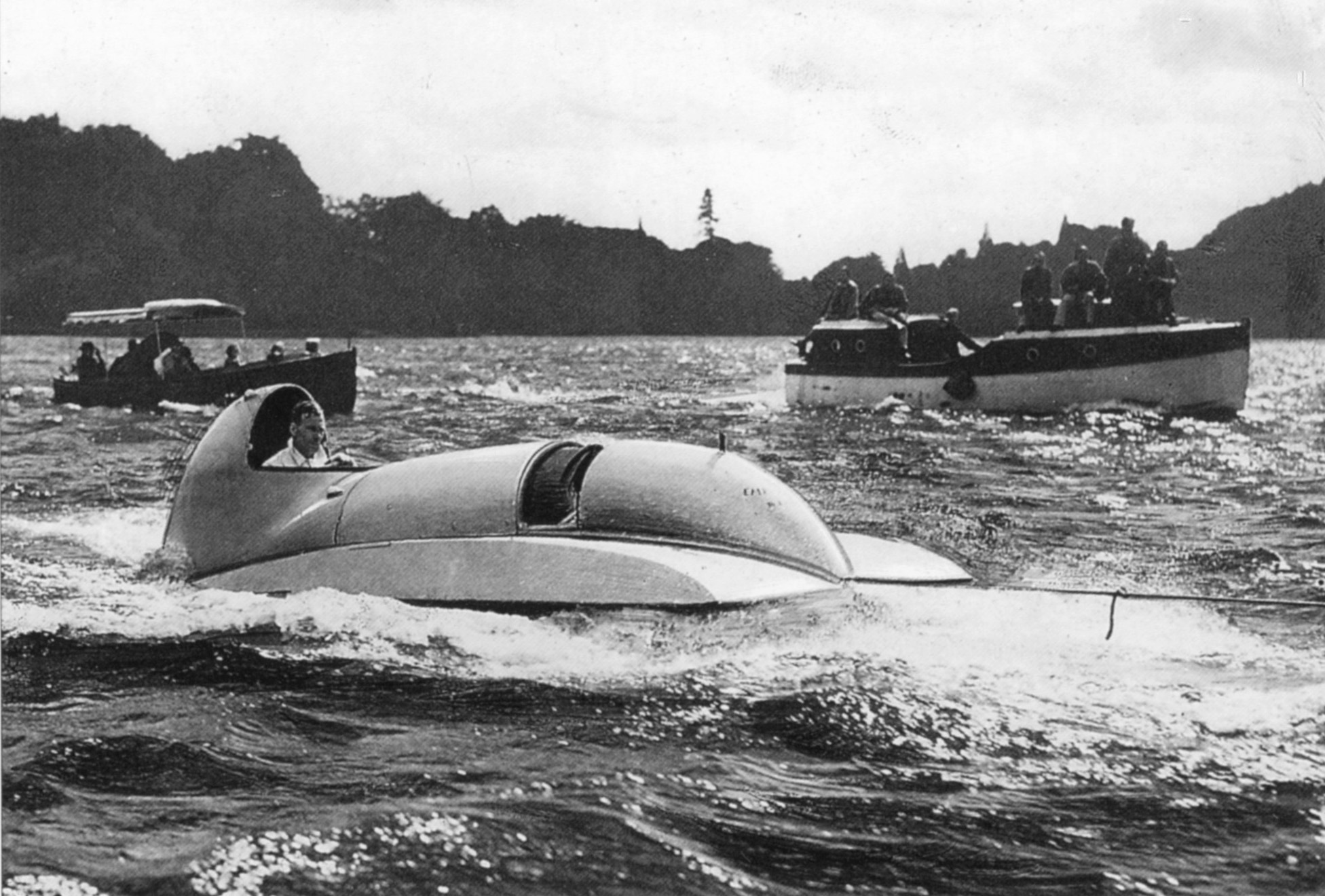
"Speedboat racing and military needs seemed to be associated once again in a British initiative which was full of promise for the Royal Navy. Le Yacht magazine in August 1938 reflected the trials of the mysterious machine known as Empire Day:
“The atmosphere of mystery which surrounded the existence of Colonel Lawrence (T. E. Shaw), the uncrowned king of Arabia, has not dissipated with his death. Even his death several years ago after a road accident has been put in doubt by those who saw in it a final maneuver by the Intelligence Service. Then time did its work, and Lawrence’s name became a legend. The most recent information published by newspapers is not calculated to destroy that. The suggestion is that before his death, Lawrence had collaborated with a modest Bradford engineer on plans for a motor torpedo boat capable of reaching a considerable speed.
“The idea is not new, and several navies are known to possess torpedo boats whose great speed and small size make them relatively invulnerable. The Japanese have gone even further by putting into service the human torpedo, a machine directed straight onto its target by a suicide pilot. Lawrence’s motor boat does not demand such self-sacrifice from its pilot. It allows him to get within a few dozen meters of the enemy warship, to launch its torpedo with perfect accuracy, and to have a chance of escaping defensive fire. Known as Empire Day, in accordance with Lawrence’s wishes, it bears witness to that sense of Empire understood by every Englishman of class. Let us remember that at the height of the illness which killed him, His Majesty King George V could still find enough strength to ask, ‘How goes the Empire?’ Lawrence’s Empire Day has just been tested on Lake Windermere. It showed such excellent seagoing qualities that the Admiralty is said to have ordered the construction of several examples of the type.”
The boat piloted by Edward Spurr could be fitted with two different engines despite its small size, a very modest 150hp 31ci or an imposing 960hp Napier ‘Lion’. Tests were interrupted by a serious fire, from which Spurr escaped thanks to a prompt response by the rescue team. The project seems to have been abandoned, as there is no record of any boat of this type being put into service.
--- Gérald Guétat'
* * *
Secretly-Built Speed Boat
LONDON, May 25.
Secretly built from designs by Edward Spurr, an engineer, aged 30 years, In collaboration with the late Lawrence of Arabia, a 16-foot speedboat christened "Empire Day" Is expected to achieve a speed of 60 miles an hour and to attack the world record of 70 miles an hour, held by an Italian, on Lake Windermere, within three weeks.
— The Sydney Morning Herald, May 26, 1938
* * *
Looking Up on Water Speedster
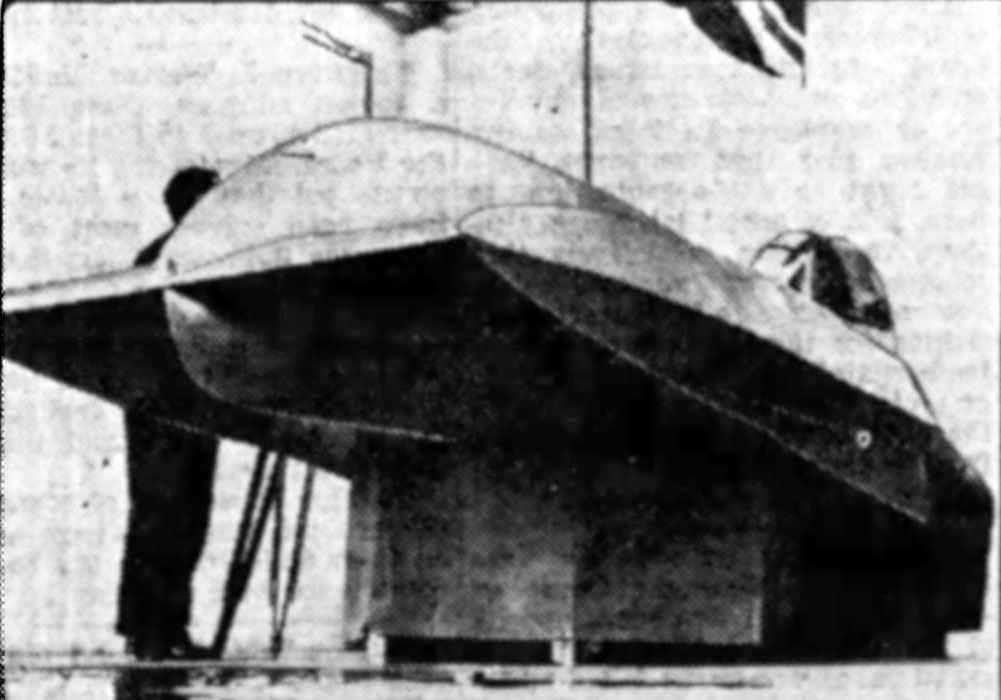
Showing the water-cutting streamlining of the latest in speedboats, the above photo is a beneath-the-bow shot of “Empire Day,” codesigned by the late Col. T. E. Lawrence (Lawrence of Arabia) and Edward Spurr and built amid great secrecy at Slough, England. The 16-foot craft, powered by a supercharged motor, is a single-seater with the cockpit entirely enclosed and the steering wheel removable to permit the pilot to enter.
— Harrisburg Sunday Courier, June 12, 1938
* * *
Test Of Speed For Lawrence Craft Near

LONDON, June 25.— (UP) — A new speedboat built along the lines of a torpedo boat envisaged by the late "Lawrence of Arabia" years ago is to undergo trials at Lake Windermere shortly. It is expected to achieve a speed of from 85 to 90 miles an hour.
The designer of "Empire Day," which is the name of the new craft, is Edward Spurr, 31-year-old Bradford engineer, who worked with Lawrence on his theories of speed boat design. Since Lawrence's death in 1935, Spurr has continued the researches and evolved the finished model.
The outstanding feature in its design is that the hull is shaped like a short plane wing. The only points of contact will be the center, where the propeller is situated, and the tail, where a rudder resembling a small knife blade will offer a minimum of resistance. The construction is of wafer-thin metal alloy.
The boat will make an attempt on the world's record for the 400 kilogram class, which is at present held by Italy and is just under 70 miles an hour.
— Napa Journal Sun, June 26, 1938
* * *
New Speed Boat Ready for Trials
LONDON, June 25. — (UP) — A new speedboat built along the lines of a torpedo boat envisaged by the late "Lawrence of Arabia" years ago Is to undergo trials at Lake Windermere shortly. It Is expected to achieve a speed of from 85 to 90 miles an hour.
The designer of "Empire Day," which Is the name of the new craft, is Edward Spurr, 31-year-old Bradford engineer, who worked with Lawrence on his theories of speed boat design. Since Lawrence's death tn 1935, Spurr has continued the researches and evolved the finished model.
The outstanding feature In Its design Is that the hull is shaped like a short plane wing. The only points of contact will be in the center, where the propeller is situated, and the tall, where a rudder resembling a small knife blade will offer a minimum of resistance. The construction is of wafer-thin metal alloy.
The boat will make an attempt on the world's record for the 400 kilogram class, which is at present held by Italy and is just under 70 miles an hour.
--- The Montana Standard, June 26, 1938
* * *
Speed Attempt On Windermere
Mr. Spurr’s Plans
Windermere. Wednesday.
Mr. Edward Spurr, who is to attack the world water speed record on Windermere, is expected here to make the attempt towards the end of this month.
Mr. Frank Hanlon, of the Windermere Engineering Company, in whose shed the boat will be housed, told a reporter today that the firm had been notified that the boat would arrive on Monday, August 22, at Lakeside station for its journey up the lake to the Bowness boat sheds. Information at present available indicates that the attempt on the record for the 1½ litre class, will be made between August 22 and 27.
Mr. Spurr’s boat, the Empire Day, is of a new type, and its owner spent two years in collaboration with Lawrence of Arabia in designing it. It can be fitted with either of two engines, one of just over 100 h.p. and the other of 960 h.p.— the latter intended for attacking the record for boats of unlimited engine capacity.
Sir Malcolm Campbell set up the present open record of 129.5 m.p.h. on Lake Maggiore last year. Mr. Spurr’s attempt will be made on the stretch of water where Sir Henry Segrave was killed in 1930.
— The Guardian, August 11, 1938
* * *
First Test Of Speed Boat
Windermere To-day
Windermere. Monday.
Mr. Edward Spurr's boat, Empire Day, in which he is to attack the water-speed record, arrived at Bowness Bay to-day. She was brought by rail to Lakeside Station, at the southern end of the lake, and towed eight miles by launch to the docks where Sir Henry Segrave's Miss England II was housed.
Mr. Spurr said that he hoped to take his boat out tomorrow for her first test. To-night will be spent on checking.
First I shall attempt the record for the 1½-litre class, and I hope to attain a speed considerably greater than the present record of 69.9 miles per hour, held by Italy." He added. "If I succeed I shall replace the engine with a supercharged Schneider Trophy unit of 1,400 horse-power and go for the world record, at present held by Sir Malcolm Campbell. Following that I shall challenge Gar Wood for the Harmsworth Trophy. ‘
Mr. Spurr states that the boat is the first designed, built, and piloted by the same man.' Empire Day has on her prow a painted miniature Union Jack, with an inscription in gratitude to Lawrence of Arabia, who collaborated in the design of the engine.
— The Guardian, August 16, 1938
* * *
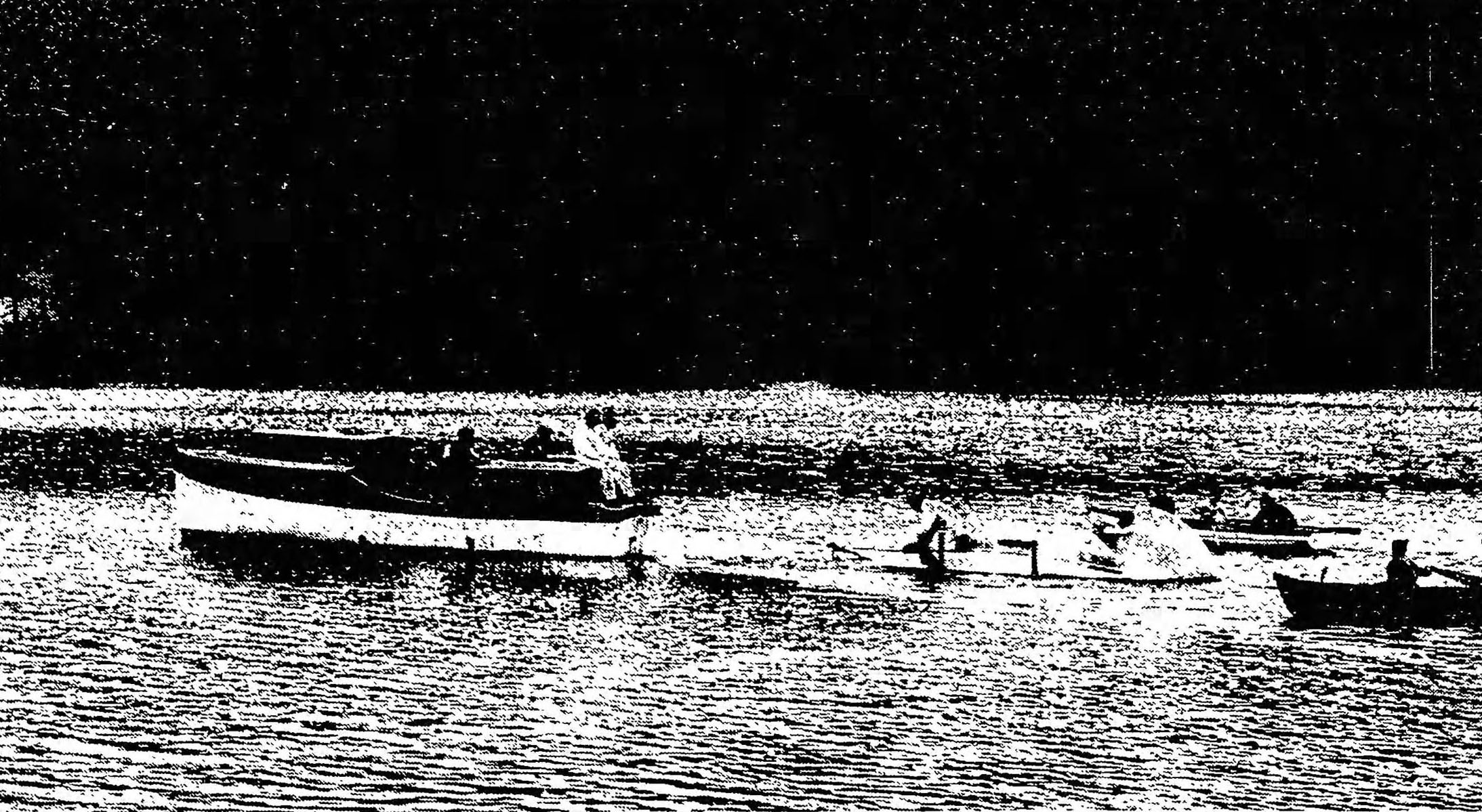
Empire Day, the speed-boat designed by Mr. Spurr and the late T. E. Lawrence, being towed across Windermere, where Mr. Spurr will make an attempt on the world speed record.
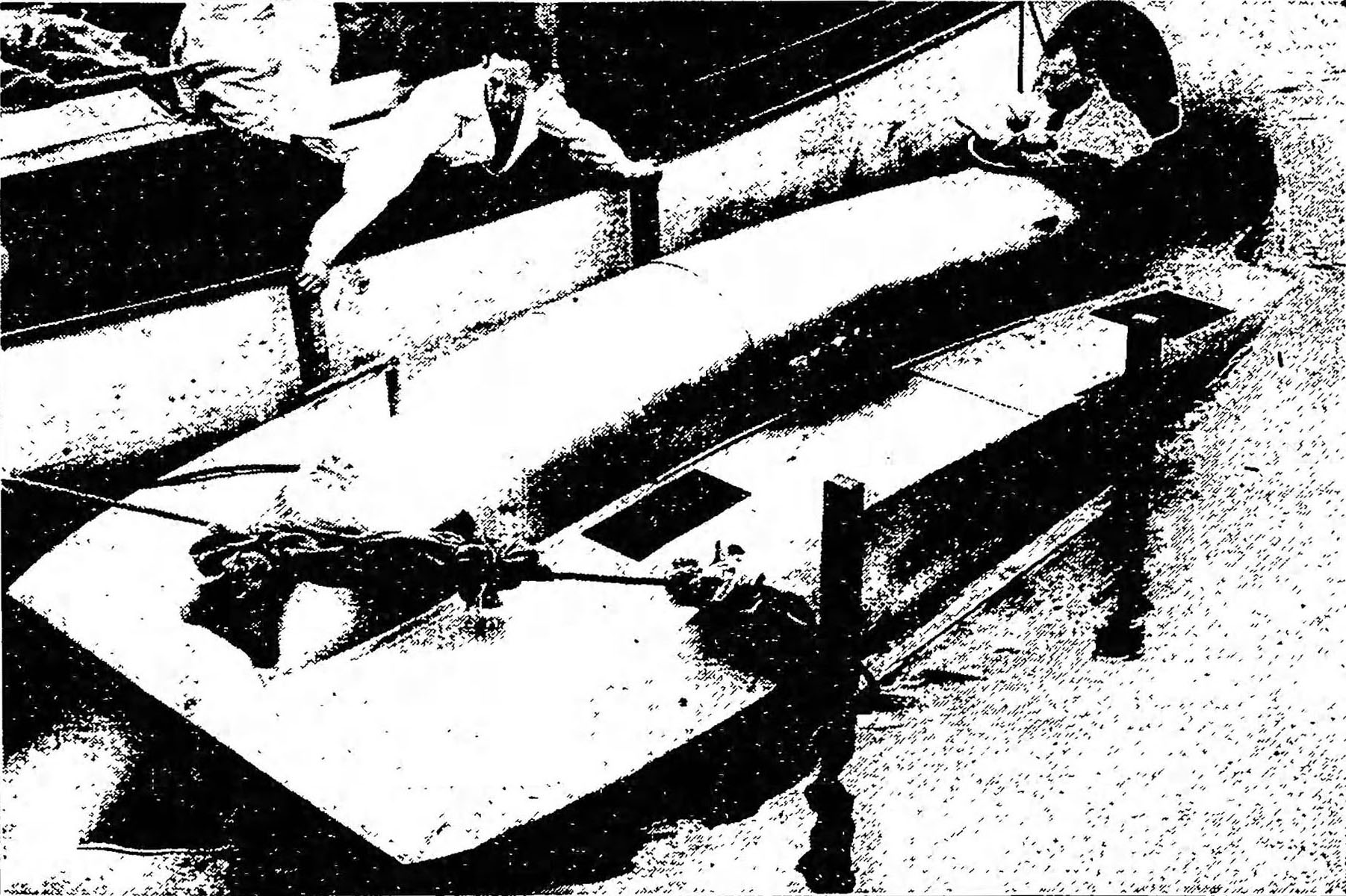
Mr. Spurr’s speed-boat Empire Day floating on Windermere on its arrival yesterday.
— The Guardian, August 16, 1938
* * *
Wind Stops Speedboat Test
Windermere, Tuesday.
A strong south-west wind over the lake made conditions unsuitable to-day for Mr. Edward Spurr to take his speed-boat Empire Day out on a trial run, but he hopes to do this to-morrow.
The boat’s propeller was fitted this morning, and the final adjustments were made, but the wind persisted, so Mr. Spurr had to be content with warming up the engine in the dock.
Empire Day is attracting hundreds of visitors to Bowness and Windermere, and people who made special excursions to-day were disappointed when the boat failed to appear from its berth.
— The Guardian, August 17, 1938
* * *
Speed Trials On Windermere
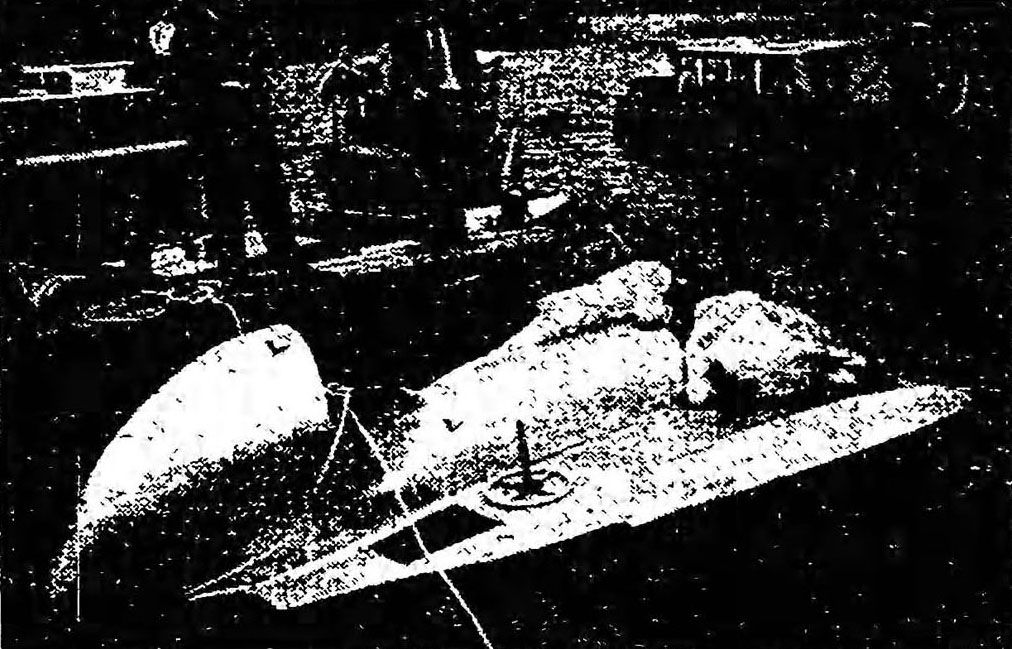
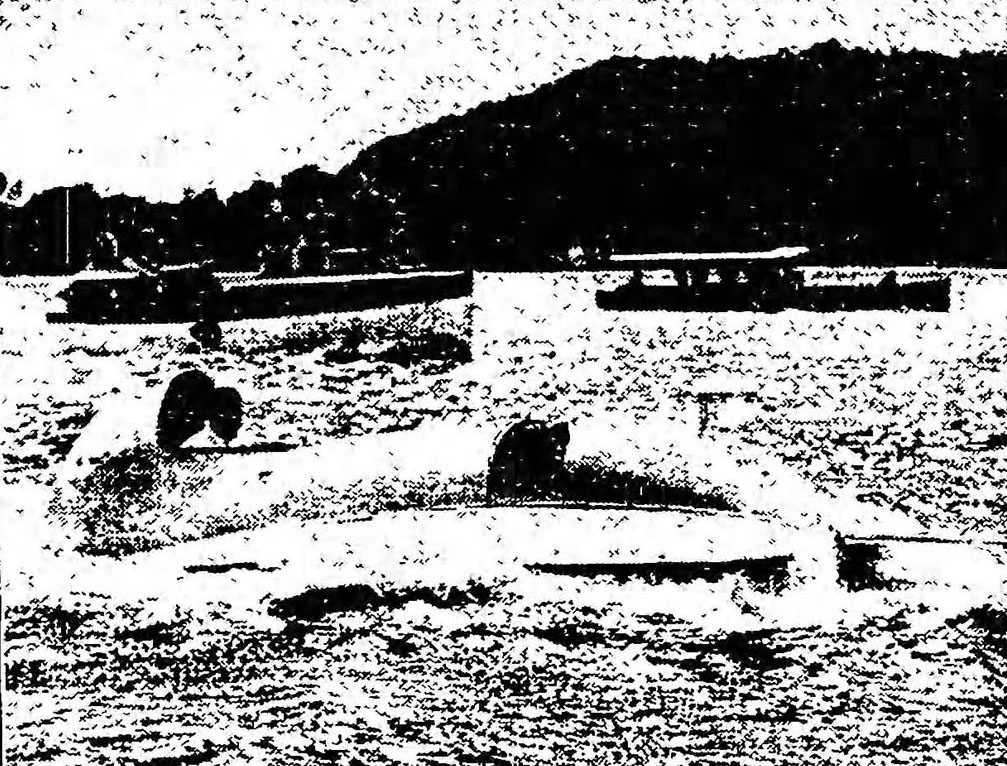
— The Guardian, August 18, 1938
* * *
First Test Of Speed-Boat
A Special Fuel
Windermere, Wednesday. Mr. Edward Spurr revealed to-day that he will use a special fuel of secret composition, which costs 25s. a gallon, for his attempt on the water-speed record, and that he has bought up the whole of the 50 gallons available in this country. He made his first test on the lake here to-day in his boat Empire Day, but after a disapointing trial run he explained that the trouble was due to the fact that he was using an ordinary petrol mixture.
"I wanted to conserve the secret fuel for the record attempts," he said. "That was why I hoped the ordinary mixture would do for the trial. The carburetter needles were set for the special fuel, and the ordinary mixture was too rich and sooted the plugs. If a special set of needles does not arrive to-morrow I shall make a trial run on my special fuel."
Mr. Spurr also stated that the special fuel gives off poisonous fumes which get into his eyes and throat. The only way to avoid this would be to extend the exhaust pipe, but this would lead to loss of engine power, so he has chosen to risk-the fumes. A point in favour of the special fuel is that at fall speed the engine keeps cool.
During to-day's trial, when Empire Day was towed out to the measured mile, it was obvious to the crowd that the performance was disappointing, for at no time was the boat travelling under its own power.
— The Guardian, August 18, 1938
* * *
Noxious Fumes In Boat
Spurr Still Unlucky
Cooling System Overhauled
Windermere, Thursday.
Mr. Edward Spurr has been out of luck since he brought his boat Empire Day to Bowness Bay to attack the world’s water-speed record, but he hopes to have a real burst of speed to-morrow over the measured mile, using his special fuel.
He made a trial run to-day, but a defect in the cooling system caused the engine to overheat and filled the cockpit with sickening fumes, which made him abandon the test. Up to a late hour to-night Mr. Spurr and three mechanics were busy refitting the original water-pump, which had been repaired.
"I was anxious to have another trial to-night.” he said, "but unsuitable weather has made that impossible. The 106-h.p. engine is now running perfectly. My chief difficulty when attempting the run this morning was caused by the poisonous fumes which nearly choked me. I had to shield my face with my hands to ward off the fumes, otherwise I think I might have been asphyxiated.”
The fumes could be carried away by lengthening the exhaust pipe, but this would reduce the engine’s power. It has been suggested that Mr. Spurr should wear a gas-mask, but he does not think that will be necessary.
— The Guardian, August 19, 1938
* * *
Windermere A "Race Track"
Councillor's Protest
Protest against Windermere being used for racing for records by speedboats was made at yesterday’s meeting of the Westmorland County Council at Kendal. Councillor N. F. Wilson, of Crosthwaite. asked if that authority had any power to regulate the racing by motor-boats on Windermere. It was a terrible pity that this beautiful lake should be turned into a racing track, and he wondered whether they had power to prevent it.
The Chairman, Alderman G. H. Pattinson, of Windermere, said that the lake was a highway, and as such was under the jurisdiction of Windermere Urban Council, and the clerk. Mr. H. B. Greenwood, said the council had no authority in the matter.
Replying to the remarks made at the meeting of the Westmorland County Council, Mr. Edward Spurr, who is conducting trials with his speedboat. Empire Day, said yesterday that It was not a question of making a speed-track of Windermere. "My trials with Empire Day are in the nature of experimental development work which will eventually be of use to the nation because of the naval torpedo boats constructed to Empire Day’s design which are almost bound to follow should my attempt on the one and a half litre class record be successful.”
— The Guardian, August 20, 1938
* * *
Speedboat Attempt More Than Record-Seeking
Mr. Spurr Finds Cure for Fumes
Windermere, Monday.
Rain and wind have given place here to-day to warm sunshine. The green and copper beeches by the road have seldom looked better, and the lake is untroubled except by the lapping waves from pleasure craft. All of this suits the visitors and, excepting the beech trees, is most satisfactory to Mr. Edward Spurr, who hopes to make his official attempt in Empire Day this week on the 400-kilogram class water speed record of seventy miles an hour.
When Empire Day was taken out this morning the magneto slipped from its coupling while the engine was at its maximum speed of 5,500 revolutions a minute. The rest of the day was spent in refltting and retiming the magneto, and Mr. Spurr was unable to go out again to-night, as he had intended to do. The boat will be taken out again to-morrow.
While experimenting with the idea of reducing the noxious exhaust fumes from his special fuel Mr. Spurr and a friend have discovered a mixture which eliminates the fumes entirely, and may possibly be adapted to make all petrol exhaust fumes non-poisonous. The nature of the mixture is being kept secret.
Final Adjustments
Mr. Spurr had sufficient trouble last week with weather, fuel, and engine, but although he is in no hurry he hopes that his work, like the weather, is now at set fair. The engine, of course, was "run in" before Empire Day was brought to Lakeside station, but by a system of trial and error the correct adjustment of the transmission has to be found. Mr. Spurr and his assistants have been working on this, trying to get that delicate balance which will have the bearings not so tight as to stall the engine and not so loose as to lose too much power. When this is done there will be the lesser task of choosing the best of four propellers—at present the smallest is being used,—and then an unofficial attempt, will be made on the record. This may be on Wednesday. At the same time the timekeepers of the Marine Motoring Association will be notified, and then the record will be challenged.
According to Mr. Spurr, the record is almost certain to be broken, but if it is not he will be satisfied with the experimental work.
"What many people have not realised." he said, "is that this is not just another record attempt, but an experiment for future use in the design of torpedo-boats."
* * *
Mr. Spurr And Council
At a meeting of the Windermere Urban Council last night Councillor J. B. Dixon, chairman of the Highways Committee, mentioned that the council's permission had not been sought for the speedboat trials conducted by Mr. Edward Spurr.
"There is no need for anyone to worry unduly about the danger of the lake being made into a race track," he said, " but before people try speedboats on Windermere it would be much better if they first approached the authorities concerned."
The Windermere Council is responsible for the larger part of the lake, and the Lakes Urban Council for the rest. Neither authority, said Mr. Dixon, wished to place any obstacles in the way of experiments which might be beneficial to the district and to the nation.
Mr. Spurr said last night that he had no wish to offend the Windermere Council, which had shown him every consideration. He left all local arrangements to the Windermere Motor-boat Club, and he thought the proper procedure had been adopted.
— The Guardian, August 23, 1938
* * *
Speedboat Ready
Further Trials To-day
Windermere, Tuesday.
After another day of hard work in the boat-shed for the mechanics and another day of disappointment for hundreds of onlookers Empire Day is ready to go on the lake to-morrow for further trials.
The trouble is only the after-effects of the magneto being shaken from its couplings yesterday and the difficulty of retiming so compact a unit of internal combustion. For one thing, it is not possible to get at the front of the camshaft, and the degree of adjustment can be judged only by trial and error. At tea-time the ignition was still too retarded, but to-night it was further advanced, and some work was done on the running-in of the transmission. It is hoped that this may be completed in dry dock, where it will be possible to examine all the bearings all the time. Only one is likely to give trouble, but it is in a difficult position.
Mr. Edward Spurr, who is always unruffled and optimistic, told me to-night that he did not expect any further delays. “If we have only a little bit of luck with the bearing I shall be out to-morrow,” he said. “ I am more than pleased with the behaviour of Empire Day on the water, but the faults that have been found take time to correct which is out of all proportion to their importance. The engine is so compact that a lot has to be dismantled to put a little right.”
In the boat-shed to-day the mechanics and an engineering friend of Mr. Spurr moved quietly and methodically among a litter of tools, bolts, screws, washers, and spare parts, their white overalls increasingly showing the smears of their trade. Their patience was matched by that of the interested watchers outside the locked doors. Boys with cameras waiting for Mr. Spurr are learning to trace the day’s disasters on his morning face, but they stay till evening for a chance snap or a quick glance at Empire Day when the doors are opened. When the engine changed its note from a stammer to a sustained roar this evening there were hundreds of people gathered by the waterside.
— The Guardian, August 24, 1938
* * *
Speed Record On Water
Mr. Spurr Again Unlucky
Mishap To Cooling System
Windermere. Wednesday.
Mist this morning and the contradictory promises of sunshine or rain which had been made by the weather here did nothing to lessen the high hopes which Mr. Edward Spurr had of his trials to-day with his speed-boat Empire Day. The mechanics worked till late last night on the timing of the engine, and in the early hours of the morning they advanced the Ignition still further. The result was that at an hour when reasonable men are in their morning baths a triumphant roar proclaimed a mile away that the boat, or at least its engine, was running as smoothly as grease on hot glass.
At three o'clock Empire Day slipped into the water and was towed up the lake attended by a mechanic in a motor-boat and an audience in floating craft of many shapes, kinds, and colours. Ninety minutes later, after running three-quarters of a mile in short bursts at a speed less than forty miles an hour, she was towed back for repairs to the water-cooling system.
Valuable Lessons
Once again Mr. Spurr had had bad luck. Once more the visitors, whether in search of thrills or a spectacular sight, had been disappointed. And yet much had been learned. Experimental work is not often sensational, and to-day was a good example. Till now Mr. Spurr had not known whether the hull would "list" in the water as calculations on paper showed that it would. Yet in four short bursts of speed the designer learned that he had not made a mistake and also discovered that Empire Day comes under control at a much lower speed than was estimated. It was thought that the pilot would have no control till 25 miles an hour was reached, but the boat answers the rudder at 15 miles an hour.
These two facts enabled Mr. Spurr to smile cheerfully as he was being towed in, and say with as much certainty as there can be in these- matters that tomorrow he will be able to open out fully. The boat will skim the surface of the water, and it will be possible to fit a smaller rudder, although to the layman this seems impossible. The present rudder is more like a carving-knife than a means of controlling a sixteen-foot boat at high speeds.
To-day's trials had to stop when a rubber joint on the water pump sheared through. It is a safety device to prevent the pump from seizing, but as it did its work when not apparently called upon to do it a harder rubber will be fitted overnight. Meantime each trial is bringing the transmission system nearer to perfection.
When he came in Mr. Spurr said, " Although I appear to be dogged by ill-luck at the moment. I am determined to break the record. The hull of the boat lifted up beautifully, and I found that I have got full control at less speed than shown in the calculations. I knew almost at once that we should have to come in, as clouds of steam were coming up on the starboard."
— The Guardian, August 25, 1938
* * *
Gathering Data About Speed
Mr. Edward Spurr's Experiments on Windermere
Windermere, Thursday.
There were fewer people to-day seeking a glimpse of Mr. Edward Spurr and his boat Empire Day. and there was no one inside the boathouse except Mr. Spurr, his colleague, Mr. N. Birkett, of Stoke-on-Trent, and his mechanics. They were working behind locked doors, which in itself lent an air of secrecy to events after a fortnight of easy freedom. Rumour spoke loudly in public places, but inside the camp patience still sat on the workbench.
The trouble of yesterday was soon repaired with a stiffer rubber coupling on the water pump. The cooling system was dismantled to see that it was undamaged, and no fault was found. With the mechanism so far undressed, opportunity was then taken to overhaul the transmission. Here again, all was found in order, but certain adjustments were made to relieve the stiffness which has been noticed when the boat is in the water. Mr. Spurr also hinted at a further experiment, but nothing could be learned about this, except that it was an idea prompted by yesterday's trials.
This work and the reassembling of the boat occupied the day, and at night Mr. Spurr said, "I shall go out to-morrow, and if Empire Day does what I expect I shall make more trials and go for the record one day next week. We have plenty of time and patience, and we are so confident that I can say definitely that I will not leave Windermere until I have attempted to regain from Italy the record for the 400-kilogram class. The boat is revolutionary in design and we must go slowly, because, apart from the record attempt, we are using her as a data-gathering craft in order to further the advance of high-speed travel on water." Part of the "revolutionary" design of the boat is that her centre of balance is exactly in the middle, where the propeller is. and the stepping which will lift the hull so that it skims the surface of the water is calculated to a fraction. Empire Day will not travel on her tail at speed. When she starts a first step lifts her nose, and as the speed increases a second step brings her stern up.
"The object," Mr. Spurr told me to-day, "is to reduce the weight. A perfect boat would pass through the water and leave it undisturbed. We hope to pass through it and leave only a ripple behind. That is why my mechanics are taking photographs of the wake, which, when studied carefully, tell me a great deal. What I have learned so far pleases me."
It is possible that before an attempt is made on the record an aerial survey will be made of the course, as some dead timber has been seen.
— The Guardian, August 26, 1938
* * *
Windermere Speedboat
A Trial Run
Mr. Edward Spurr, of Bradford, went out for an early morning trial yesterday in his speedboat Empire Day, on Windermere. Although Empire Day only travelled at a moderate speed, Mr. Spurr was satisfied with the performance., it was the most successful test since arriving at Windermere a fort-night ago "The engine is now in perfect condition and giving no trouble," he said, "The propeller I was using was rather on the big side and I shall have to experiment with a smaller one. Empire Day rode the water perfectly and I am sure she will be safe at high speeds."
— The Guardian, August 29, 1938
* * *
Speedboat Put To Test
A Hopeful Run
Trying A Larger Propeller
Windermere. Tuesday.
Mr. Edward Spurr took out his boat Empire Day for a trial run on Windermere this afternoon, and when questioned on the result he said he could take the record easily. Certainly he and his mechanics were all smiles when they returned.
Following the secret trial in the early hours of Sunday morning, the whole of Monday was given over to readjustments, and Empire Day was tried out in her dock this morning. She was going well, and so this afternoon she was taken up to the measured mile.
Describing the run Mr. Spurr said: “I had to open, the engine up to get away, but at about 15 miles per hour the boat was rising, on her step and I had to slide the throttle quickly back. The boat then dropped in the balance for which it is designed and was travelling perfectly as I again increased speed. During one burst when I touched some 3,000 revolutions per minute mv speed would be approximately 55 miles per hour. I was at no more than half-throttle at the time, and the propeller I was using is the smallest we have. I will try a larger propeller tomorrow after making some adjustments.”
Empire Day’s engine is designed for 7,000 revolutions per minute, and with this reserve Spurr is confident of raising his speed to 70 miles an hour, at which the record now stands.
— The Guardian, August 31, 1938
* * *
Speed Trial On Windermere
Empire Day Out Again
Windermere. Wednesday.
Crowds cheered Mr. Edward Spurr as he stepped from the cockpit of his speedboat Empire Day this evening after another successful trial on Windermere.
A strong south-westerly wind made the lake choppy, but Empire Day rode the water smoothly, and Mr. Spurr said he was well satisfied with the boat's performance over the measured mile. He would not divulge the speed, but it is believed to have been in the region of 45 to 50 m.p.h.
Mr. Spurr explained that at no time did he have the engine "flat out", but it responded perfectly to acceleration. To improve the steering Mr. Spurr is to fit a damper to the rudder, and this will be done to-morrow.
— The Guardian, September 1, 1938
* * *
Speed-Boat's Best Run
60 m.p.h. on Windermere
Empire Day, the speed-boat with which Mr. Edward Spurr hopes to break the Italian record of 69 miles an hour for the 1½-litre class, made its best run so far on Windermere yesterday. A speed of sixty miles an hour was attained over a quarter of a mile, with the throttle not fully open.
Mr. Spurr said that no day bad yet been fixed for the attempt on the record. Be docked the boat on feeling vibration, and found that a propeller blade was doubled up.
— The Guardian, September 5, 1938
* * *
73 Miles An Hour On Windermere
An Unofficial Record
Windermere, Thursday.
Mr. Edward Spurr to-day unofficially broke the 1½-litre speedboat record of 69 miles an hour when his boat Empire Day travelled over the mile on Winder-mere at a speed of 73 miles an hour. On the return journey the propeller flattened out under the pressure of even greater speed. Another propeller was tried on two runs but proved unsuitable.
Mr. Spurr says he is delighted with the performance, but he still has the propeller problem to solve.
— The Guardian, September 9, 1938
* * *
Speed-Boat In Flames
Spurr's Escape
Mechanics To The Rescue
Windermere, Thursday.
Mr. Edward Spurr had a remarkable escape from serious injury this evening when his speed-boat Empire Day caught fire while travelling at 45 miles an hour on Windermere. Mr. Spurr managed to stop the boat, although blinded by smoke and fumes, and his mechanics, who were in another motor-boat, rescued him from the covered cockpit.
The boat was considerably damaged, and will, have to be sent away for a complete overhaul.
Mr. Spurr was making his first test of a new propeller over the measured mile when half-way along the course he thought he detected fumes, and a few seconds later he saw flames coming from near the fireproof bulkhead.
"I stopped the boat and directed a fire extinguisher at the seat of the flames," he said. " My mechanics. Bob Fields, Reg Kester, and Joe Lashmer. were close at hand in a motor-boat, and with their help my headshield was removed and I managed to crawl from the cockpit into their boat..
"The flames had then reached the cockpit, and the mechanics, using an extinguisher from their boat, helped me to put them out.
"I am hoping that the boat will be fit for further trials in a few weeks. I am still determined to go for the world's record. It was a lucky escape for me, and I really owe my life to my mechanics. I was not seriously hurt, but my eyes were scorched and my breathing was affected. I recovered after about an hour."
— The Guardian, September 16, 1938
* * *
Lawrence of Arabia Held ‘Death Ship’ Secret
Planned Fleet of Speedy Craft Capable of Killing Thousand In 5 Minutes
80-Mile-an-Hour Boat To Receive Teat In Record Run
New Tactics
(Special Dispatch to the Herald) London—A plan for squadrons of 10-mile-an-hour death ships each one of which could kill a thousand man In five minutes, was the secret which Lawrence of Arabia took to the grave when he crashed to death three years ago. This was revealed after Lord Strabolgi, behind the closed doors of a Slough (Bucks) engineering factory had christened a 16ft speedboat, capable of 85 m.ph., which Lawrence helped to design.
When this boat—Empire Day—attacks Italy's 400-kilogramme world record on Lake Windermere, Admiralty chiefs will he watching, for it Is on this craft that Lawrence planned shoals of 100ft torpedo boats which he contended would wipe out an entire enemy fleet in less than a week.
If the trials are a success, the government are expected to place orders for squadrons of these vessels.
The only man who knows Lawrence's secret, Edward Spurr, 31-year-old ship designer, is confident he will break the world record by at least ten miles an hour, and thus make Britain the most feared nation on the seas.
Operate In Squadrons
"The boats," he says, "would operate In squadrons, like the R.A.E., and they would attack enemy ships from all angles. They will revolutionize sea-flghtlng tactics. If we had had these boats In the Great War the Battle of Jutland would have been over In 10 minutes,” he claimed.
When Lawrence died In a road crash, Spurr carried on, and following five years' research he perfected the boat Although only 100 feet long It will carry four 21-Inch torpedo tubes, powerful gunnery and depth charges. Torpedoes could be released at 80 m.p.h. from under the boats without being seen by enemy vessels. One boat could scuttle four hostile battleships with direct hits In eight seconds!
When the Idea for these death ships came to Lawrence he and Spurr worked for months making models with matchsticks and old metal.
Great Analytical Mind
"Lawrence and I found most of our Inspiration in sleep at my lodgings in Southampton," Mr. Spurr says. "Lawrence had a great analytical mind. Although he was not an engineer he had amazing mechanical understanding and could put his finger on a weak spot and suggest modifications to get out of difficulties.
"The great secret is that torpedoes can be fired fore and aft at two-second intervals without being delected. They can ship 200 men at a time from point to point at great speed, which would make them vital In a blockade."
The fastest vessel of Its kind In England today has a top-speed of 40 m.p.h.
Colonel T. E. Lawrence became known as Lawrence of Arabia mainly because of the way he rallied the Arabs to the British cause in the Great War. After the Armistice he returned to England and lived in retirement In Dorset for some time Then, for a whole, there was some mystery concerning his whereabouts and eventually he was found serving as an ordinary aircraftsman In the R.A.F. under the name of Shaw.
— Calgary Herald, October 4, 1938
[It would appear that Empire Day I was either retired due to damage or completely rebuilt to create Empire Day II]
* * *
Bayonet-Rudder at 160 m.p.h.
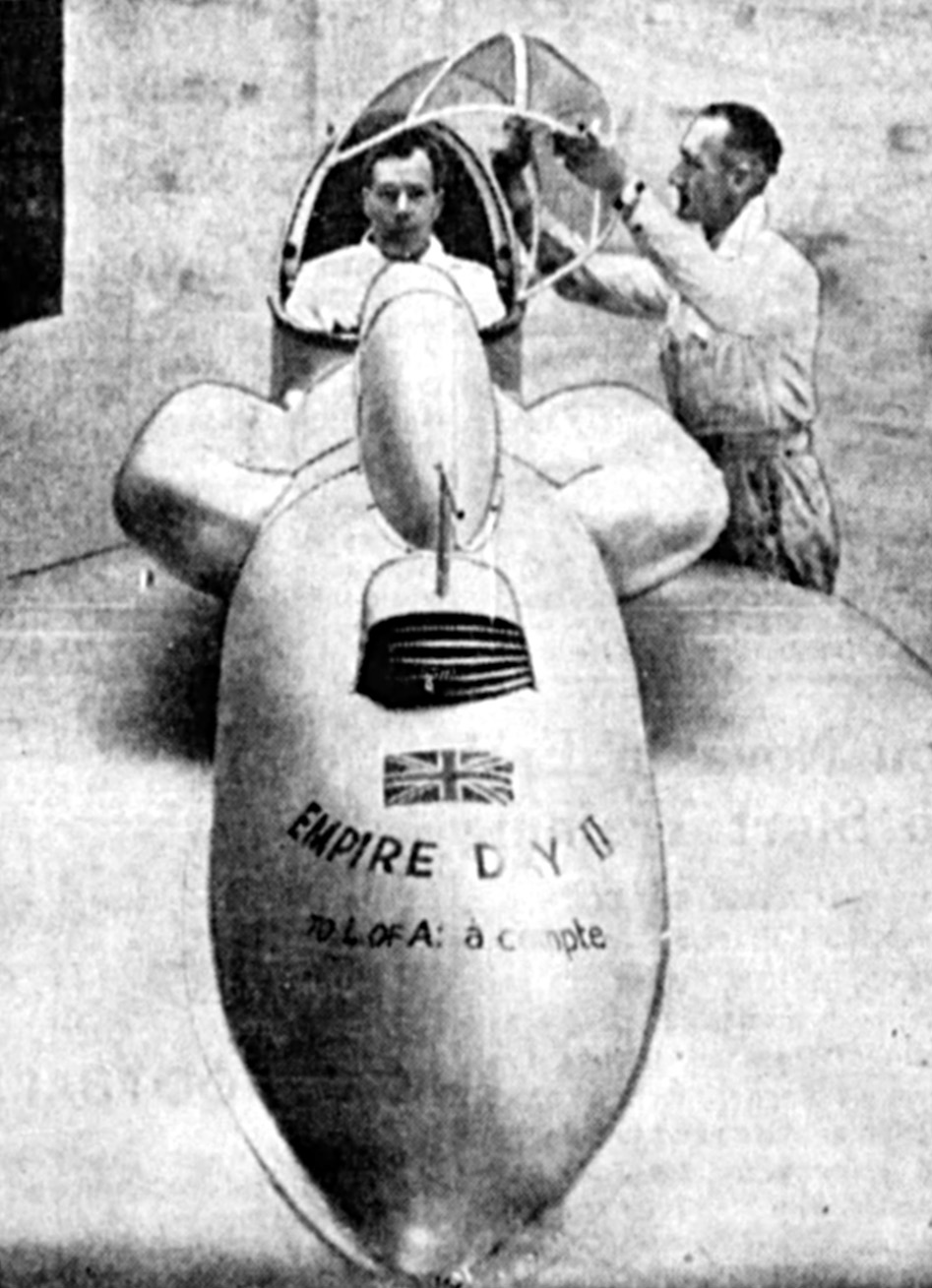

LONDON.—This is the tale-of three men who, with three £10,000 boats, will stage this summer a needle battle for the world water speed record.
The men are:
Sir Malcolm Campbell (holder), 51-year-old Scot, Mr. Edward Spurr, 31-year-old Englishman; and Count Theo Rossi, 35-year-old Italian.
Sir Malcolm Campbell, holder of the present record (130.0 m.p.h,), is building a new Bluebird of 2,160 hp with which he has hopes to do at least 140 m.p.h. He is searching Britain for a stretch of fresh water five miles long and at least 30 feet deep.
Count Rossi is building a 140-150 m.p.h. boat backed by the resources of the Italian government and his country’s greatest motor and marine engineers.
Lightest Ever.
Mr. Spurr has already built his boat. Empire Day II, and, on Lake Windermere this Summer, hopes to do between 150 and 160 miles an hour.
Empire Day II is the result of his friendship wfth Colonel Lawrence of Arabia. They met when Spurr was chief designer to the biggest builders of powerboats in the country, and for three years they experimented together on hulls to cheat the wind.
Lawrence died, but this part of his many activities went on. Spurr built Empire Day I last year. She had a small engine, was built to do 80 mph, and did it first time.
The new boat. 16 ft long, weighs only Just over 17 cwt., and it the lightest ever built for her power (930 h.p.).
She is steered by a rudder the size of a bayonet, which does not come into operation until she gets up to 50 miles an hour, so that at low speeds Spurr has no control.
At speed only an inch or two of the hull remains on the-water.
— The Ottawa Journal, April 1, 1939; Star Phoenix, April 25, 1939
* * *
[No further mentions of the Empire Day project were found in newspaper sources; it is unclear if Empire Day II continued development. England entered WWII in September 1939.]
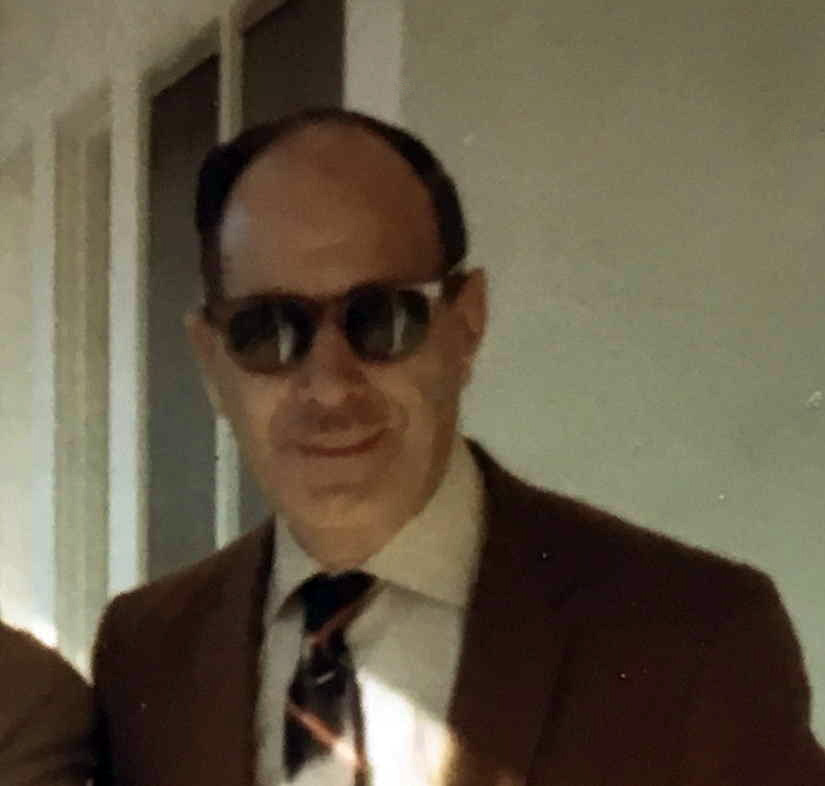
EPILOGUE: Edward Spurr relocated to Los Angeles in 1956 and became a US Citizen in 1968. He passed away in San Luis Obispo, California in 1998]
